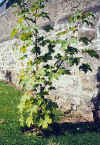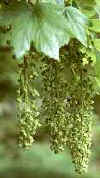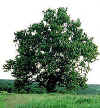Stop 2 on Trail 1 Stop 1 on Trail 3 Sycamore fruit Mature Sycamore
Back to Trail 2
Back to Trail 3 The Sycamore
Seiceamar ( Irish )
Acer pseudoplatanus
The common name refers to the unrelated eastern fig or Ficus sycomorus which has large palm-shaped leaves too.The scientific one reveals that this tree belongs to the genus Acer - the maples - while pseudoplatanus means "false plane". In Latin, acer means "sharp" as maple wood was good for making spears.
Easily the largest member of the maple family in Europe, this large round-topped tree can reach 40m in height with a 1.5m girth trunk.
It is not native to Britain or Ireland. Its real home is high ground in southern and central Europe extending northwards to Paris and east to the Caucasus.
When and who first introduced sycamore to Britain is uncertain. It may have been the Romans but it was still scarce there in the 16th century and has only really become established over the last 200 years
The sycamore it is a stout erect tree, which grows very quickly, reaching a height of seventy feet in about fifty years, but it does not live much more than one hundred and fifty years.
The trunk is greyish-brown and smooth, and bears many robust twisting branches, which are bluish-grey in old trees. In spring, the small pale green flowers hang in clusters. Along with field maple and limes, sycamore is the only common tree with insect pollinated flowers and is a vital source of pollen and nectar for bees. The leaves are five-lobed and carried on long stalks. They appear in April and turn yellow before falling in October. The flowers hang down in long, golden-green clusters and appear in May.
The fruit is a winged nut, but the nuts are usually in pairs, so the wings look like aeroplane propellers. They come twisting down in October. Sycamore is a deciduous species - the large palm-shaped leaves on their long stalks fall off as winter approaches
The timber is creamy-white in colour, hard and strong, clean and free from unpleasant smells or tastes, making it ideal for uses associated with food. It is widely used for furniture making and joinery and is excellent for flooring. The hard, strong timber can be worked to a very smooth finish but it is not durable out-of-doors without preservative treatment..It is used for making such things as kitchen utensils and table-tops, and also as flooring.




